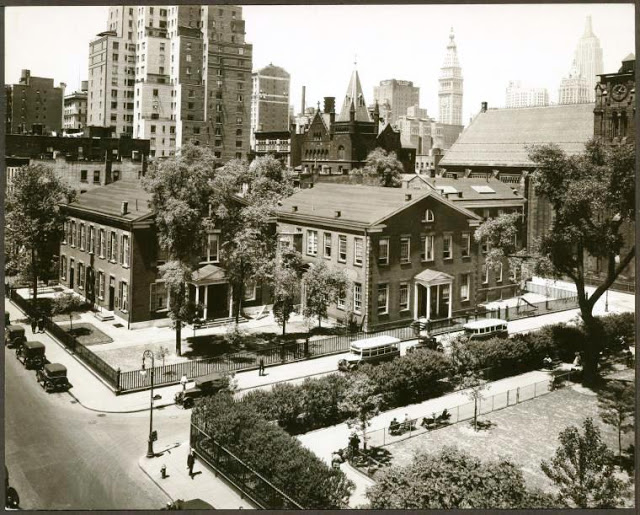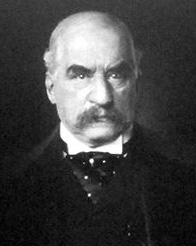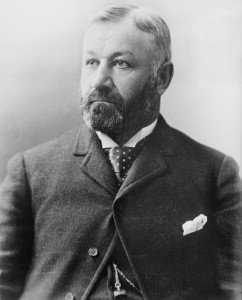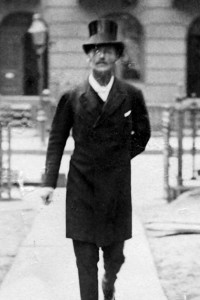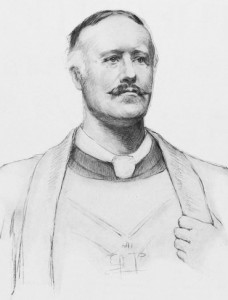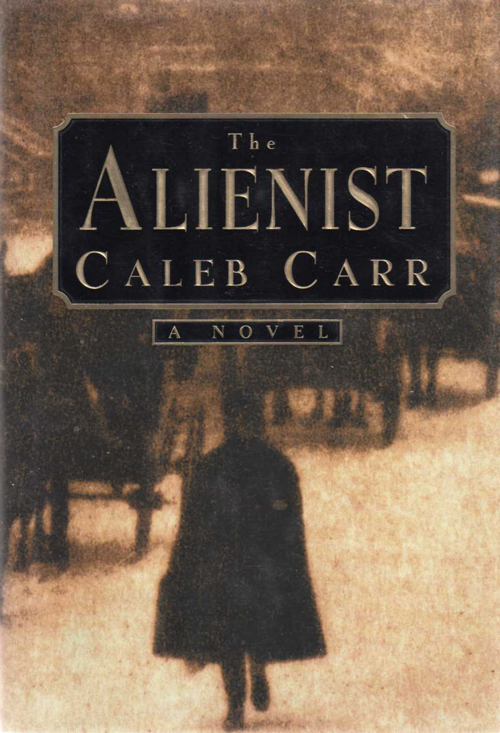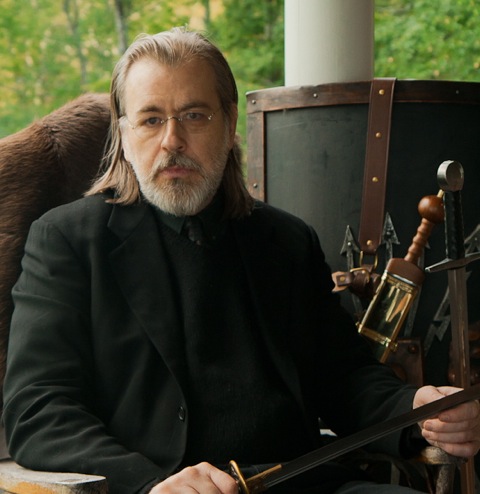Welcome to Part Three of the “Did Dr. Kreizler really live at 283 East 17th Street?” series. In Part One, we overviewed the early development of Stuyvesant Square from its rural origins to the start of construction in the district in the 1840s. In Part Two, we overviewed the greatest periods of growth in the district, the 1850s to early 1880s, and learnt about the first owner-occupants of the houses in the neighborhood, many of whom were successful merchants, along with the tenants of the district’s first apartment houses who were predominantly writers and theater people. In Part Three, we will learn more about Stuyvesant Square as it was during the critical periods for Alienist books, the 1880s and 1890s, and will focus our attention on some of the most prominent characters that contributed to the shaping of the district’s character during this period.
Stuyvesant Square’s fall from grace in the early 1880s
Even though the architectural charm of Stuyvesant Square had been established thirty years earlier with the building of handsome residential and religious buildings around the district’s attractively landscaped public park, by the early 1880s the district was becoming a shadow of its former self. Tenement populations were now encroaching on the neighborhood, and the district’s wealthier residents had begun to move further uptown in response. Although the park itself was still frequented by neighborhood children, the neglected park’s grass was no longer receiving any maintenance, its flowers had all but disappeared, and its two large fountains were filled with rubbish from the streets rather than water. One contemporary even recalled seeing “dead cats and empty tomato cans” piled in the fountain basins.
At the same time, the district’s iconic St. George’s Episcopal Church that had once drawn some of the largest congregation numbers of any religious institution in New York was also in the process of an equally sharp decline. Congregation numbers had started to fall while under the pastorship of the aging Rev. Dr. Tying in the early 1870s, and numbers had dropped still further following his death. During this period, St. George’s was funded by pew holders, of which there were few remaining due to the wealthy parishioners migrating uptown, and had accumulated $35,000 in floating debt. The financial situation had reached such a precarious point by the late 1870s that there were even reports that the Roman Catholic Church had been approached by members of the vestry to take the church over as a mission. Although members of St. George’s had tried on several occasions to build their numbers up through outreach to the poor, all attempts had been unsuccessful and were eventually abandoned.
When St. George’s attendance numbers reached their bleakest point in the early 1880s, the extremely conservative wardens and vestrymen of the church made a radical decision to approach the passionate reformer, the Rev. Dr. William S. Rainsford, to take over pastorship of the church. Although a surprising choice for an old-fashioned church, this decision would prove to not only turn around the fortune of the failing church but would help to shape the character of the district as a whole in the years to come.
The district rises again with the arrival of St. George’s radical new rector
The son of an evangelical Irish minister, the Rev. Dr. Rainsford spent his childhood moving between poor Irish parishes and fashionable London society. Although he saw his father as an aspirational figure, he had developed a love of hunting and adventure in his youth, and decided upon a career in the Royal Artillery instead of the church. However, before he was able to pursue his ambitions, Rainsford was asked by a family friend to speak at a meeting of working mothers in London’s poverty stricken East End. This first taste of ministering to the poor, combined with his later adventures hunting buffalo with Native Americans where he had felt that “poverty was not a necessity … everyone had a chance,” prompted him to become interested in seeking better conditions for the families in downtrodden areas and ultimately led him to take up orders in the church.
After spending the early years following his ordination in various parishes throughout England and Canada, the Rev. Dr. Rainsford received two opportunities to preach at St. George’s Church in the 1870s. Through these experiences, he knew that attendance at the church was dwindling and therefore declined the position of rector when it was first offered to him in 1882. Nevertheless, troubles arose with his own church in Toronto a year later, and he eventually agreed to visit New York again to discuss the conditions under which he might be willing to accept the post. One of the senior vestrymen of the church at the time was none other than John Pierpont Morgan, the prominent financier who received a noteworthy cameo in The Alienist. Readers may remember a scene in Part Three of the novel in which Dr. Kreizler and John Moore were forcibly taken to a meeting with J. P. Morgan, Anthony Comstock, and various religious officials in the study of Morgan’s brownstone residence on Madison Avenue. Although the meeting’s purpose was to discuss the implications of the team’s investigation into the murders, Morgan’s connections to St. George’s Church were briefly mentioned as well.
“And what of these other questions, about the social implications of your work? I must admit that I am not well acquainted with such matters. But as you may know, I am senior warden of St. George’s Church, across Stuyvesant Park from your own house.” One of Morgan’s coal-black eyebrows went up. “I have never seen you among the congregation, Doctor.”
“My religious opinions are a private matter, Mr. Morgan,” Laszlo replied.
Chapter 30, The Alienist
It was also in J. P. Morgan’s famous study that the Rev. Dr. Rainsford and members of St. George’s vestry met to discuss his taking up the post of rector. Not intimidated by the financier’s reputation, Rainsford listed three highly unusual conditions that needed to be met before he would agree to accept the position. First, the vestry would need to abolish pew fees and make the church free. Second, they would need to abolish all pre-existing committees within the church, except the vestry, so that Rainsford could gain tighter control over the running of the church. And finally, Rainsford needed to be provided with an annual fund of $110,000 for three years, independent of his salary, for use as he saw fit for church work. Rainsford stated that, “Dead silence followed. I saw Mr. Morgan look round that circle of tense faces. Then he looked full at me and said one word: ‘Done.'”
The change within the church and the neighborhood following the Rev. Dr. Rainsford’s appointment was remarkably swift. As part of one of his first duties upon becoming rector, he made a point of visiting all pre-existing members of the church, including those who had not been in attendance for a number of years. One of these included a very profitable trip to Staten Island to visit the elderly mother of Richard Croker, the new boss of nearby Tammany Hall. Upon discovering that Rainsford had taken the time to visit his mother who had not had a clerical visit for many years, Croker offered the new rector “any courtesy in his power,” and Rainsford went on to describe in his autobiography just how useful having a Tammany boss on your side could be:
After that, the change in our park, if not immediate, was assured; and in time we had quite beautiful flowers grouped round the fountains, and, what was even more important than a restored beauty, we had the invaluable service and cooperation of an intelligent and sympathetic park policeman, who greatly helped us for many years.
In addition to restoring the church surroundings to a welcoming environment as well as his immediate abolishment of pew fees, the Rev. Dr. Rainsford’s primary aim in his early days was to reach out to the children of the Lower East Side who he saw as being of greatest need in society. His first endeavor in this regard was to set up a Sunday School in a large back room of a saloon on Avenue A, between 15th and 16th Streets (now part of Stuyvesant Town). Although the first class at Avenue A dissolved into chaos when a group of street boys formed a flying wedge and knocked him to the ground when he tried to call the group to order, Rainsford was persistent. He knew that the success or failure of St. George’s would lie with the children of the Lower East Side, but the importance of the endeavor went far beyond the church to the rector:
Here I had my first real meeting with the living thing Jacob Riis afterward immortalized as “Tony,” and I love to remember that Riis first saw Tony pasting the ugly old stained-glass windows of St. George’s (the lower ones) with mud. If we had things to teach Tony, Tony certainly had much to teach us. His home a slum tenement, no room or little room for him at school, no understanding of him when he did get a place in school, and when he broke from the school’s unsympathetic and most unnatural restraint, then a bad law, shamefully administered, which tied his wild, vivid boyhood up with older and vicious criminals, in a prison for truants. No place to play but the street, and no peace in the street for the ubiquitous “cop,” his natural enemy. Everything that stood for order and for property, the policeman, the landlord, the church, all were against him. Even in the parks he was faced with “Keep off the grass,” so there was nothing left to him but the gutter … My heart went out to those romping ragamuffins who had thrown me on the floor. What a dirty and neglected crew they were, and yet what infinite possibilities! What abundant life was packed away under their ragged jackets!
With the help of patient volunteers from the church, he persevered with the Sunday School behind the saloon and the school eventually became a success with numbers increasing from 150 attendees per week in the early days to over 2,000 by the end of Rainsford’s time as rector. At the same time the Sunday School was being run at Avenue A, the St. George’s Boys’ Club was established in a small house on East 21st Street to provide the boys with a lending library (libraries were rare in those days) as well as any classes the boys requested; mostly industrial training. In addition to the Sunday School and the Boys’ Club, Rainsford also established regular trips to Rockaway Beach during the hottest months of the year to provide poor mothers and their children with respite from their tenement homes and the city heat, accommodating an estimated 12,000 to 16,000 individuals over the years that followed.
The radical new rector couldn’t have made half as great a success of St. George’s as he did without the unwavering support of his senior warden, J. P. Morgan. Although Morgan was a religious conservative who disagreed vehemently with many of his rector’s more controversial teachings such as his open discussions of birth control and evolution, as well as Rainsford’s firm belief that the church’s attempts to save men’s souls from a distant hell were frequently condemning them “to suffer in a very real present hell,” and his wish to “banish the supernatural” from religious teachings stating that, “I believe in the Lord Jesus as a man, a real man. I believe he was born of the love of a good man and a good woman, as God intended all of us to be born. I believe he lived as men live, that he died as men die, only in unparalleled torture,” the financier cared deeply about the success of his church. Seeing what good the rector was doing in the parish as well as his unusual integrity in all his dealings, Morgan placed his full financial support behind Rainsford regardless of their differences in belief.
Over the years that Rainsford was rector at St. George’s, Morgan anonymously donated hundreds of thousands to the church, including one particularly generous donation of $200,000 for the building of the Parish House in 1886 behind the church on 16th Street, the first of its kind in New York. The Parish House would go on to house Rainsford’s assistant clergy rooms, a large reception hall, classrooms, a gymnasium, and meeting rooms for various organizations such as the Girls’ Friendly Society for working girls. The House was open on Monday nights for everyone who wished to attend “from Pierpont Morgan to the last adopted Armenian refugee.” Taking a similar view of the church itself which, by this point, was full to overflowing–there were occasions when Morgan himself couldn’t find a seat–the rector had his ushers seat attendees according to order of arrival rather than social standing. One prominent business man recalled, “I came as a stranger, and the usher put a poor colored woman alongside me. That is the church for me, I said to myself.” Under his pastorship, the St. George’s membership grew from 200 to over 4,000.
The rector’s connections to another Alienist character, Theodore Roosevelt
Although not directly related to Stuyvesant Square, it is also worth noting that the Rev. Dr. Rainsford had connections to another prominent figure in the Alienist books, Theodore Roosevelt. Although the pair’s first contact while Roosevelt was Police Commissioner and Rainsford was rector at St. George’s was in opposition (Rainsford opposed the closing of saloons on Sundays believing it would simply result in men drinking at home, while Roosevelt supported the measure), over subsequent years the men struck up an honest and frank correspondence that developed into friendship during their later years, with Rainsford even offering his services as chaplain in 1917 had Roosevelt’s special volunteer division in the war been accepted. Rainsford highly valued his friendship with Roosevelt who he described in the following terms:
He was hated by some and feared by some, as a good man if he is brave (which good men too often are not) ever must be. But he was the most loved and trusted man of our time. He honored me first with an acquaintanceship, and later with a friendship, for which I can never sufficiently thank him. He had faults, of course. These stood out on the surface of the man. He was at times intemperate in his advocacies as well as in his oppositions. I do not think that his judgement of men was unusually good, though he had confidence in his judgement of men. He was impetuous, a trifling fault. He was ambitious, a second-class virtue. As father and husband there could be none more tender or more true. To the land he ruled and loved, his highest faith and an almost religious devotion were given. For her sake “he counted not his life dear unto himself.” To me, he was the kindest, most charitable, most faithful friend a man ever had … We loved him, that Greatheart of our time! And many, many of us would have gladly died in his place, if by our dying he might have lived on, once more to guide and rule the land he loved.
Roosevelt, too, valued the work that Rainsford had done while rector at St. George’s and admired both his physical and mental fortitude, and strong moral character. It therefore seems fitting to end Part Three of the blog series with an excerpt Roosevelt wrote following Rainsford’s retirement from St. George’s Church in 1906, which explains his view of the lasting impact the rector made on New York City and the Nation as a whole through his work at Stuyvesant Square:
The Church must be a living, breathing, vital force, or it is no real church; and therefore not only all good citizens, but especially all earnest Christians are under a real debt of obligation to the Rev. William S. Rainsford for what he has done with St. George’s Church in New York … He was keenly alive to everything that appeals to men as men, and his broad and deep sympathies made him keenly sensitive to the needs of others, no less than to the way in which these needs could be effectively met. With such an equipment, he took an empty church and filled it … He made these men and women feel that whether they were rich or poor mattered nothing, so long as they were Christians who tried to live their Christianity in a spirit of brotherly love and of sane, cheerful helpfulness toward themselves and toward one another … With his strong human hand he felt the throbbing pulse of the people among whom he worked, and he fired their hearts with the spirit that was in his own. As a preacher, as an executive, as a citizen among his fellow citizens, Dr. Rainsford made St. George’s Church the most notable institution of its kind in the world. He did lasting work for social and civil righteousness. Not only New York City but the Nation as a whole owes him a debt of gratitude for his molding of American citizenship in the form in which it should be cast.
To Be Continued
In Part Four of the blog series, we will be touching on another building in the Stuyvesant Square district associated with J. P. Morgan, the New York Lying-In Hospital, when we discuss the question of why Caleb Carr might have chosen the neighborhood as the home of his protagonist. In order to do this, we will be examining other medical, creative, and civil influences around the square during the 1890s, and will briefly touch on how the district’s demographic composition continued to change in the early 20th century.

